8 Best Vegetables To Shrink Belly Fat
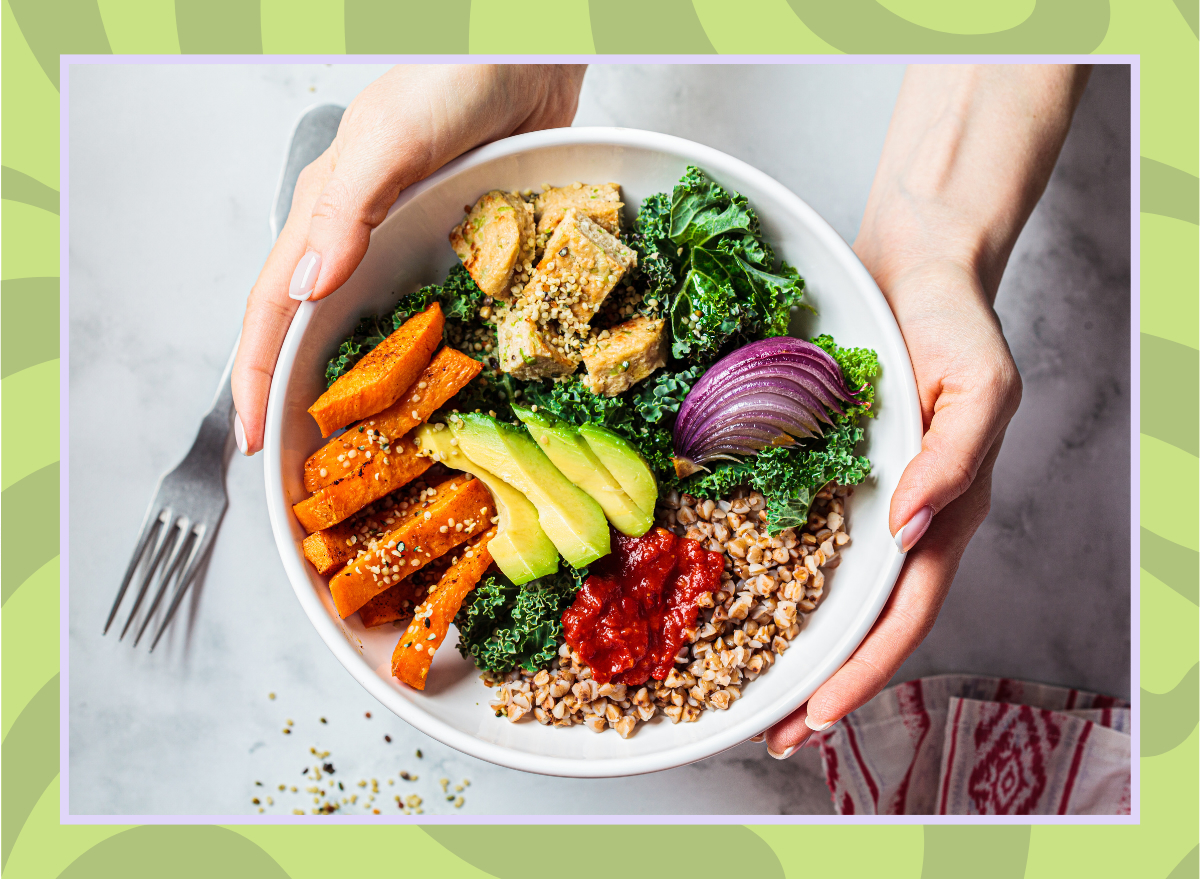
There isn’t a vegetable out there without some kind of health benefit. Vegetables are nutrient-dense, antioxidant-rich, and versatile foods that can improve digestion, regulate blood sugar, lower your risk of disease, and support healthy weight loss. Beyond these general benefits, some vegetables also contain specific nutrients that may help with belly fat reduction.
It’s important to note that no single food can eliminate belly fat on its own. Factors like genetics, age, diet, and lifestyle play significant roles in excess belly fat, and addressing it requires a balanced, holistic approach. For instance, Harvard Health says that exercising, avoiding tobacco, lowering stress, and eating a balanced diet low in added sugars can help you achieve your belly fat loss goals.
So, when we talk about the best vegetables for losing abdominal fat, we are including veggies that contain certain nutrients helpful to this process, but we encourage you to include these foods as part of a full and balanced eating plan.
To learn more about these veggies and the nutrients they contain that can help with your goal of losing abdominal fat, we spoke with Trista Best, MPH, RD, LD, registered dietitian and consultant with Balance One Supplements, and Courtney D’Angelo, MS, RD, registered dietitian and author at Go Wellness. Read on, and for more tips on eating healthy, check out these 31 Weeknight Dinner Ideas to Kickstart a Healthy 2025.
Broccoli
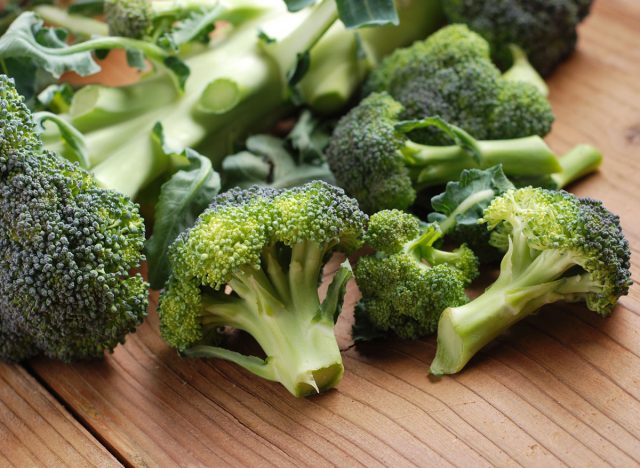
Broccoli is one of the most nutrient-dense vegetables you can find, which is why both of our dietitians swear by this green veggie as a food for helping to manage weight around your abdomen.
“This cruciferous vegetable is rich in antioxidants that help drive down inflammation in the body,” says Best. “The primary compound is sulforaphane, which works by lowering cytokines and NF-kB in the body. These substances drive the inflammatory process. By reducing inflammation, the body is better able to release weight and work efficiently in every other area as well.”
Research confirms broccoli is a good vegetable for belly fat. One study published in the Journal of the Academy of Nutrition and Dietetics found that regularly consuming dark green vegetables (which includes broccoli and leafy greens like kale and spinach) helped decrease visceral fat in overweight Latino youth participants. Similar results were found with bright yellow and orange vegetables, such as carrots and bell peppers.
Carrots
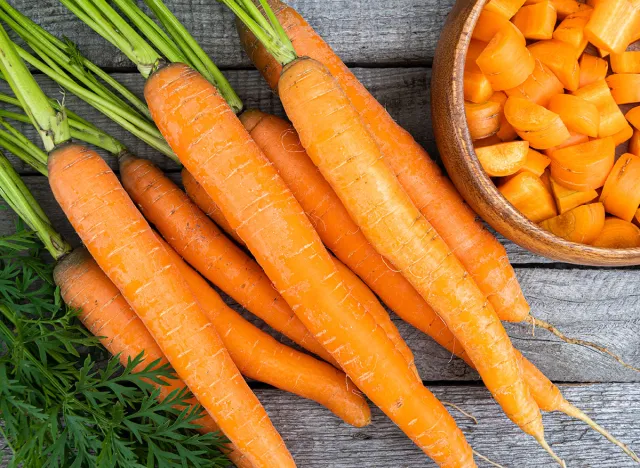
The research from Journal of the Academy of Nutrition and Dietetics included carrots in their conclusion of helpful vegetables for belly fat, adding that carrots and broccoli were the most common vegetables consumed among participants.
Carrots are rich in a type of plant compound called lutein, which research has shown has antioxidant capabilities, as well as potential links to helping lower abdominal fat tissue. On top of that, Best says that chewing raw carrots may actually help with metabolism.
“This vegetable is unique in its ability to help reduce belly fat in the fact that it raises the body’s metabolism,” says Best. “The thermogenic effect of food (TEF) is the rate of calories a food causes the body to burn while being digested. Because carrots have a hard texture, they have a high TEF and therefore cause the body to burn more calories simply by eating them.”
Lettuce
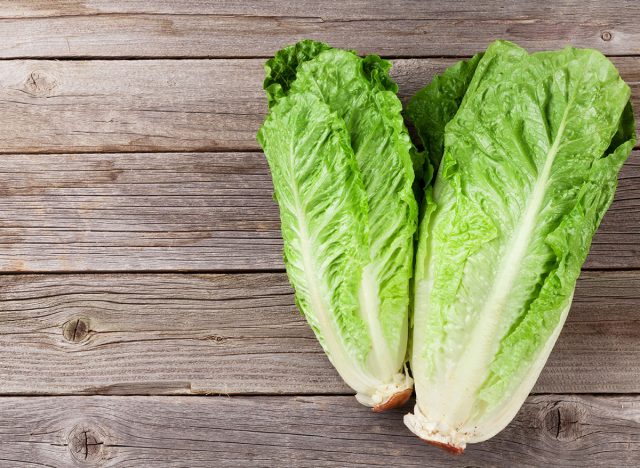
Another vegetable that provides helpful nutrients linked to abdominal fat loss is lettuce. First off, lettuce is high in lutein, the plant compound we already mentioned has a potential impact on decreasing belly fat. This compound is part of a larger group of compounds called carotenoids, which include lutein, lycopene, and zeaxanthin—all of which have antioxidant properties. Along with being antioxidants, some research supports these compounds as being able to help with fat loss, too.
One study on Japanese men with obesity found that increasing carotenoid-rich vegetables (which includes lutein-rich veggies like lettuce) can reduce visceral fat—a type of abdominal fat located near vital abdominal organs.
Lettuce was also mentioned in the Journal of the Academy of Nutrition and Dietetics study on Latino youth as a green vegetable linked to abdominal fat loss.
Orange & Yellow Bell Peppers
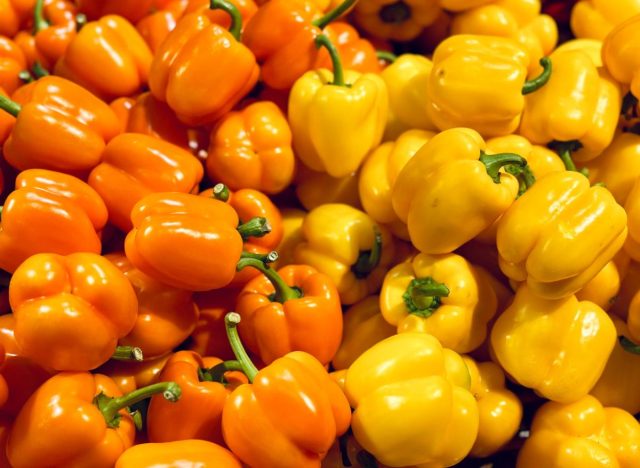
Other vegetables that are rich in lutein (the compound linked to abdominal fat loss) are orange and yellow bell peppers. These bright, tasty veggies are great additions to an eating plan fit for losing belly fat, and they’re easy to enjoy in a variety of different dishes or on their own.
One study published in the British Journal of Nutrition found that when paired with a low-calorie diet, lutein supplementation had several positive effects on participants. Those who supplemented lutein saw a decrease in waist circumference, visceral fat, body weight, and body fat, as well as lower LDL cholesterol levels.
Beets
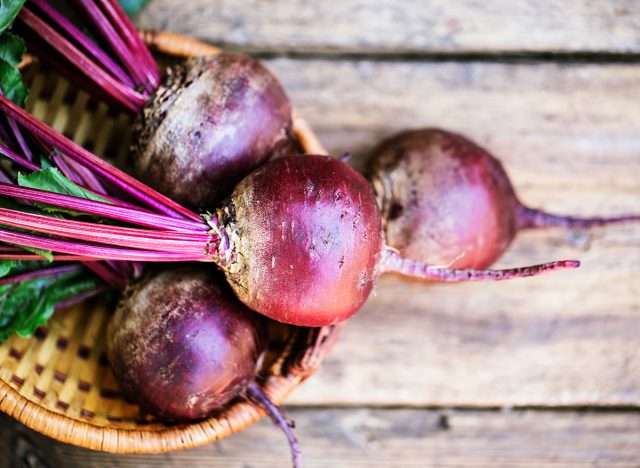
Beets aren’t talked about nearly enough, but these earthy root vegetables are packed full of nutrients that can help you manage weight around your stomach area, while maybe even improving digestion.
This vegetable is high in fiber, at around 3.8 grams per cup. Eating enough fiber at each meal or snack is known to help prevent bloating, decrease appetite, and increase your feelings of fullness. Fiber can also help improve the health of your gut microbiome, something that is crucial in maintaining or losing weight healthily.
Along with being able to help with general weight loss, fiber is also crucial in abdominal fat loss as well. For instance, one study published in the Journal of Clinical Endocrinology & Metabolism found that a diet higher in fiber was associated with less visceral fat.
Kale
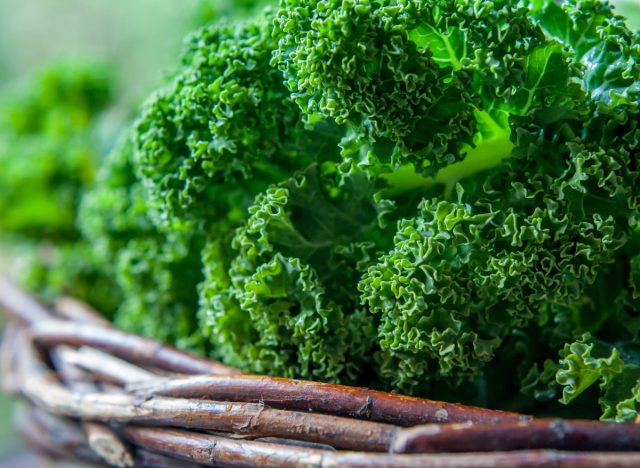
Kale is a leafy green vegetable packed full of nutrients. With this yummy leaf, you’ll get vitamins A, K, C, and B6, as well as manganese, copper, and potassium. You’ll also get fiber and protein as well, for only around 43 calories per 100 grams.
Remember that study we mentioned about dark green vegetables helping to reduce abdominal fat? Kale is included in this list of dark green veggies, so incorporating more of this leafy food into your diet can help you work toward your goals of less fat around your stomach.
Spinach
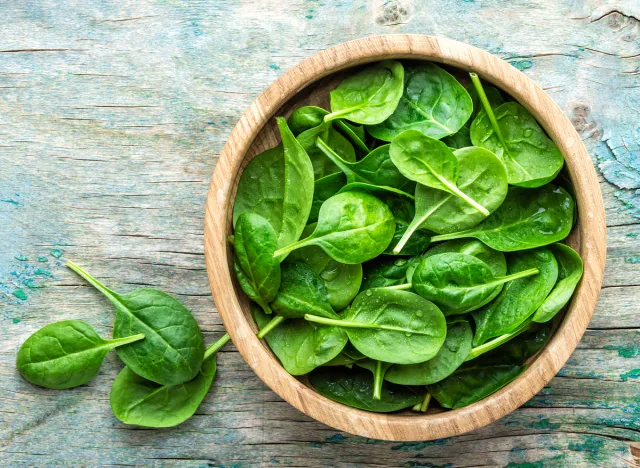
Pass the spinach, please! This leafy green is full of nutrients and great as a salad, sautéed, or thrown into your protein smoothie. According to our dietitians, adding more spinach to your diet can help you lose belly fat.
“Leafy green vegetables are not only super nutritious, but they also help you shrink belly fat,” says D’Angelo. Spinach contains some fiber, which can help with digestion and gut health, and “It’s also high in vitamin K, which can sometimes support the reduction of body weight, including visceral fat,” adds D’Angelo.
Red Bell Peppers
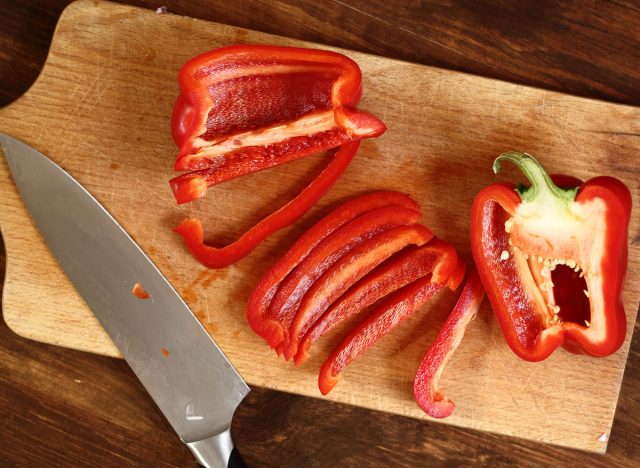
Red bell peppers are a versatile vegetable with a natural sweetness that goes great in a stir fry or on top of your burrito bowl. They’re also full of nutrients that can help you with your abdominal fat loss goals.
“Bell peppers are ideal vegetables to add to a weight loss diet,” says Best. “They are low in calories and high in nutrients, while also helping to create a sense of fullness after meals. This combination can help to prevent overeating throughout the rest of the day.”
Another perk of red bell peppers is that they’re high in a type of carotenoid called lycopene, and we’ve learned that carotenoid-rich vegetables can potentially aid in reducing abdominal fat.
- Source: Harvard Health. (2021, April 12). Taking aim at belly fat. https://www.health.harvard.edu/staying-healthy/taking-aim-at-belly-fat
- Source: Treasure, K., Harris, J., & Williamson, G. (2023). Exploring the anti‐inflammatory activity of sulforaphane. Immunology & Cell Biology, 101(9), 805–828. https://doi.org/10.1111/imcb.12686
- Source: Cook, L., O’Reilly, G., Goran, M. I., Weigensberg, M. J., Spruijt‐Metz, D., & Davis, J. N. (2014). Vegetable consumption is linked to decreased visceral and liver fat and improved insulin resistance in overweight Latino youth. Journal of the Academy of Nutrition and Dietetics, 114(11), 1776–1783. https://doi.org/10.1016/j.jand.2014.01.017
- Source: Cook, L., O’Reilly, G., Goran, M. I., Weigensberg, M. J., Spruijt‐Metz, D., & Davis, J. N. (2014). Vegetable consumption is linked to decreased visceral and liver fat and improved insulin resistance in overweight Latino youth. Journal of the Academy of Nutrition and Dietetics, 114(11), 1776–1783. https://doi.org/10.1016/j.jand.2014.01.017
- Source: Abdel-Aal el-SM, Akhtar H, Zaheer K, Ali R. Dietary sources of lutein and zeaxanthin carotenoids and their role in eye health. Nutrients. 2013 Apr 9;5(4):1169-85. doi: 10.3390/nu5041169. PMID: 23571649; PMCID: PMC3705341.
- Source: Stahl, W., & Sies, H. (2003). Antioxidant activity of carotenoids. Molecular Aspects of Medicine, 24(6), 345–351. https://doi.org/10.1016/s0098-2997(03)00030-x
- Source: Takagi, T.; Hayashi, R.; Nakai, Y.; Okada, S.; Miyashita, R.; Yamada, M.; Mihara, Y.; Mizushima, K.; Morita, M.; Uchiyama, K.; et al. Dietary Intake of Carotenoid-Rich Vegetables Reduces Visceral Adiposity in Obese Japanese men—A Randomized, Double-Blind Trial. Nutrients 2020, 12, 2342. https://doi.org/10.3390/nu12082342
- Source: Cook, L., O’Reilly, G., Goran, M. I., Weigensberg, M. J., Spruijt‐Metz, D., & Davis, J. N. (2014). Vegetable consumption is linked to decreased visceral and liver fat and improved insulin resistance in overweight Latino youth. Journal of the Academy of Nutrition and Dietetics, 114(11), 1776–1783. https://doi.org/10.1016/j.jand.2014.01.017
- Source: Abdel-Aal el-SM, Akhtar H, Zaheer K, Ali R. Dietary sources of lutein and zeaxanthin carotenoids and their role in eye health. Nutrients. 2013 Apr 9;5(4):1169-85. doi: 10.3390/nu5041169. PMID: 23571649; PMCID: PMC3705341.
- Source: Hajizadeh-Sharafabad F, Tarighat-Esfanjani A, Ghoreishi Z, Sarreshtedari M. Lutein supplementation combined with a low-calorie diet in middle-aged obese individuals: effects on anthropometric indices, body composition and metabolic parameters. British Journal of Nutrition. 2021;126(7):1028-1039. doi:10.1017/S0007114520004997
- Source: https://fdc.nal.usda.gov/fdc-app.html#/food-details/169145/nutrients
- Source: Akbar, A. (2023, May 1). High fiber diet. StatPearls - NCBI Bookshelf. https://www.ncbi.nlm.nih.gov/books/NBK559033/
- Source: Myhrstad MCW, Tunsjø H, Charnock C, Telle-Hansen VH. Dietary Fiber, Gut Microbiota, and Metabolic Regulation-Current Status in Human Randomized Trials. Nutrients. 2020 Mar 23;12(3):859. doi: 10.3390/nu12030859. PMID: 32210176; PMCID: PMC7146107.
- Source: Parikh S, Pollock NK, Bhagatwala J, Guo DH, Gutin B, Zhu H, Dong Y. Adolescent fiber consumption is associated with visceral fat and inflammatory markers. J Clin Endocrinol Metab. 2012 Aug;97(8):E1451-7. doi: 10.1210/jc.2012-1784. Epub 2012 May 16. PMID: 22593589; PMCID: PMC3410273.
- Source: FoodData Central. (n.d.-c). https://fdc.nal.usda.gov/fdc-app.html#/food-details/323505/nutrients
- Source: Cook, L., O’Reilly, G., Goran, M. I., Weigensberg, M. J., Spruijt‐Metz, D., & Davis, J. N. (2014). Vegetable consumption is linked to decreased visceral and liver fat and improved insulin resistance in overweight Latino youth. Journal of the Academy of Nutrition and Dietetics, 114(11), 1776–1783. https://doi.org/10.1016/j.jand.2014.01.017
- Source: FoodData Central. (n.d.-d). https://fdc.nal.usda.gov/fdc-app.html#/food-details/168462/nutrients
- Source: Knapen MHJ, Jardon KM, Vermeer C. Vitamin K-induced effects on body fat and weight: results from a 3-year vitamin K2 intervention study. Eur J Clin Nutr. 2018 Jan;72(1):136-141. doi: 10.1038/ejcn.2017.146. Epub 2017 Sep 27. PMID: 28952607.
- Source: FoodData Central. (n.d.-e). https://fdc.nal.usda.gov/fdc-app.html#/food-details/170108/nutrients
- Source: Takagi T, Hayashi R, Nakai Y, Okada S, Miyashita R, Yamada M, Mihara Y, Mizushima K, Morita M, Uchiyama K, Naito Y, Itoh Y. Dietary Intake of Carotenoid-Rich Vegetables Reduces Visceral Adiposity in Obese Japanese men-A Randomized, Double-Blind Trial. Nutrients. 2020 Aug 5;12(8):2342. doi: 10.3390/nu12082342. PMID: 32764462; PMCID: PMC7468729.